

2016 March 11
(DEC 28) WAUKESHA, WI - The Quadrantid meteor shower will put on its best show in the early morning of January 3. Observers who escape city lights and clouds can expect to see 100 meteors per hour.
Quadrantid meteors strike Earth's upper atmosphere at 90,000 mph. Dust-size particles are incinerated, which creates a column of incandescent gas we see as a meteor.
The shower's radiant - the point from which all its meteors seem to originate - lies in the constellation Bo÷tes the Herdsman. This region once belonged to the now extinct constellation Quadrans Muralis the Mural Quadrant, hence the shower's name.
Sharp-eyed observers can see meteors from this shower between January 1 and 5, but the peak on the 3rd is sharp - the numbers are low even a day away from maximum. This year, the Moon will pose no problem, setting before 9 p.m. local time.
Information courtesy of Astronomy Magazine
(DEC 27) The first student-built instrument ever selected to fly on a NASA planetary mission is scheduled for launch from Kennedy Space Center on January 17. The Student Dust Counter will monitor space as part of the New Horizons mission to Pluto and beyond. More
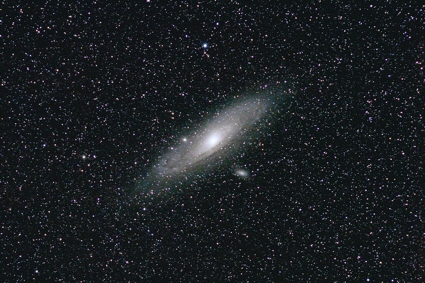
Barely visible to the naked eye, the Andromeda Galaxy shows extensive detail in this telephoto view by Colorado sky photographer Ginger Mayfield. She captured several digital images of the galaxy with her EOS 10D camera and 200mm telephoto lens and processed and combined the images to create this photo. Copyright 2005, Ginger Mayfield.
(DEC 21) NASA's Stardust mission is nearing Earth after a 2.88 billion mile round-trip journey to return cometary and interstellar dust particles back to Earth. Scientists believe the cargo will help provide answers to fundamental questions about comets and the origins of the solar system. More
(DEC 20) MCLEAN, Va. - International Launch Services (ILS), a Lockheed Martin joint venture, has received authorization from the U.S. Air Force to proceed with the launch of a military weather satellite on an Atlas V vehicle from Vandenberg Air Force Base, Calif.
The launch is scheduled for late 2007 with a spacecraft built for the Defense Meteorological Satellite Program. Both the Atlas vehicle and the satellite, known as DMSP-18, are built by Lockheed Martin.
This mission was assigned to Lockheed Martin through ILS under the Air Force's Evolved Expendable Launch Vehicle (EELV) program. This is the ninth of 16 assignments to be placed under a firm contract with go-ahead for launch.
The Atlas V vehicle will launch in the "401" configuration, standing 57 meters (188 feet) tall with a 4-meter-diameter (13.75-foot) payload fairing. Atlas V vehicles in this configuration flew successfully in August 2002, May 2003 and August 2005.
DMSP spacecraft are used for strategic and tactical weather prediction to aid the U.S. military in planning operations at sea, on land and in the air. Equipped with sophisticated sensors that operate in both the visible and infrared spectra to peer through cloud cover, the satellite collects specialized meteorological, oceanographic and solar-geophysical information in all weather conditions.
Lockheed Martin has refurbished Space Launch Complex (SLC) 3-East at Vandenberg to accommodate the Atlas V vehicle. The first launch scheduled from the new pad is a mission for the National Reconnaissance Office in 2006.
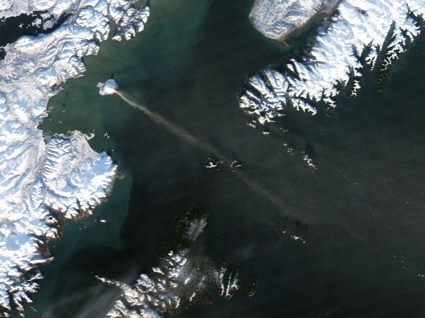
Augustine Volcano in the Gulf of Alaska erupted on December 12, sending a plume of ash and steam approximately 50 miles (80 kilometers) toward the southeast. The Moderate Resolution Imaging Spectroradiometer (MODIS) onboard the Aqua satellite captured this image the same day. In this image, the volcanic plume streams from the tiny, snow-capped volcanic island and dissipates over the ocean. Aqua was launched from California in 2002. Image courtesy of Jesse Allen and the MODIS Rapid Response team.
(DEC 17) For the second time in a week, the Moon will pair up with a naked eye planet. The waning gibbous Moon will pass 3.5° from +0.0 magnitude Saturn this Monday morning at 03:50 PST (11:50 UTC). The separation and time of closest approach were calculated for Los Angeles and may vary for other locations.
(DEC 14) TUCSON, Ariz. - A Raytheon Company Exoatmospheric Kill Vehicle (EKV) was a key element in the latest successful flight test of the Ground-based Midcourse Defense (GMD) system conducted Dec. 13 over the central Pacific Ocean.
This test, designated Flight Test-1, demonstrated the system's capability to launch a ground-based interceptor, EKV separation and delivery of the EKV to the desired point in space and time. No target was launched although the test was conducted as if there were a target. The interceptor was launched from the U.S. Army's Reagan Test Site at Kwajalein Atoll in the Republic of the Marshall Islands.
The test was designed to show the successful operation of the Raytheon EKV, developed and manufactured at the company's Missile Systems business in Tucson, with an Orbital Sciences Corp. booster. The EKV separated from the booster as planned, conducted in-flight sensor calibration, conducted a star- shot to determine its own position to very precise accuracy, communicated with In-Flight Interceptor Communication System Data Terminal, and exercised its divert engines. When no target was located, the EKV performed a "step-stare" maneuver to enlarge its search area.
Adapted from a Raytheon news release

This view from NASA's Mars rover Spirit looks in the drive direction on the rover's 680th Martian day, or sol (December 1). The outcrop of apparently layered bedrock has the informal name "Algonquin". JPL manages the Mars Exploration Rover project for NASA's Science Mission Directorate. Image courtesy of NASA/JPL-Caltech/Cornell
(DEC 1) Nearly five decades after the Minuteman ICBM missile entered the United State's nuclear arsenal as President John F. Kennedy's "Ace in the Hole," Hill technicians are working to ensure it continues on "active duty" for the foreseeable future. More
(DEC 8) Observers in the Southwest and beyond can watch a celestial near-miss this Sunday evening as the Moon's orbit carries it within 0.6° of Mars. From Los Angeles the Moon will make its closest approach to the Red Planet at 20:22 PST. Since Mars is quite bright, the December 11 pairing should be easily visible to the naked eye. Although the two objects will appear to be close to one another, Mars will be more than 57 million miles behind the Moon.
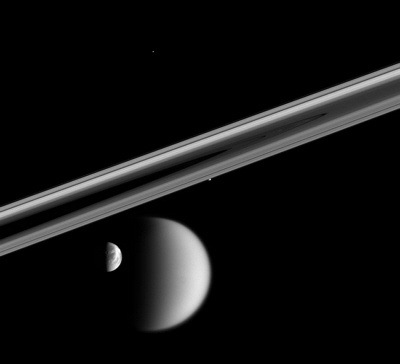
The Cassini spacecraft captured this portrait of a near-alignment of four of Saturn's restless moons. Seen here are Titan (the largest moon) and Dione at bottom; Prometheus hugs the rings at center; Telesto is a mere speck in the darkness above center. The moons were on the far side of the rings with respect to the spacecraft. JPL manages the Cassini mission for NASA. Image courtesy of NASA/JPL/Space Science Institute
(DEC 2) NASA's Spitzer Space Telescope is bringing new light - infrared light - to the study of our dark and mysterious universe. Some of the observatory's most exciting discoveries will be discussed in free public lectures on Thursday, Dec. 8 and Friday, Dec. 9.
Dr. Michael Werner, project scientist for Spitzer at NASA's Jet Propulsion Laboratory, Pasadena, Calif., will present, "The Spitzer Space Telescope: Exploring the Infrared Universe," at 7 p.m. both days. The Dec. 8 lecture will be held at JPL, while the Dec. 9 event will be at Pasadena City College's Vosloh Forum.
Seating for both lectures is first-come, first-served. The Dec. 8 lecture will be in JPL's von Karman Auditorium. JPL is at 4800 Oak Grove Dr., off the Oak Grove Drive exit of the 210 (Foothill) Freeway. The Dec. 9 lecture will be in Pasadena City College's Vosloh Forum, 1570 E. Colorado Blvd. The Dec. 8 lecture will be webcast live and archived later at http://www.jpl.nasa.gov/events/lectures/dec05.cfm. For more information, call (818) 354-0112.
Adapted from a Jet Propulsion Laboratory news release
(NOV 29) THOUSAND OAKS, CA -- CRISM (Compact Reconnaissance Imaging Spectrometer for Mars) is one of six scientific instruments on NASA's Mars Reconnaissance Orbiter launched from Cape Canaveral Air Force Station in Florida on August 12, 2005. Two major imaging sensor components of the CRISM instrument were designed and fabricated by Rockwell Scientific Company. More

Mars continues to shine brightly in the evening sky and provided the webmaster with a convenient target for spectroscopy. He took this spectrogram of the Red Planet on November 26 using a tripod mounted digital camera with a diffraction grating in front of the lens. In reality, this is the spectrum of sunlight reflected by the Mars. Despite its simplicity, the image reveals a few dark absorption lines. Copyright 2005, Brian Webb.
(NOV 25) Saturday's maiden flight of a Falcon 1 rocket was scrubbed due to an incorrect valve setting. SpaceX Corp. of El Segundo, California planned to launch the booster from Kwajalein Atoll in the Central Pacific and place an Air Force Academy student-built satellite into orbit.
According to SpaceX's Elon Musk "The reason for the delay was an auxiliary liquid oxygen (LOX) fill tank had a manual vent valve incorrectly set to vent. The time it took to correct the problem resulted in significant LOX boiloff and loss of helium, and it was the latter that caused the launch abort. LOX is used to chill the helium bottles, so we lose helium if there is no LOX to cool the bottles."
A new launch date will not be available for at least a week because liquid oxygen and helium need to be shipped to the launch site from Hawaii.
(NOV 23) SUNNYVALE, Calif. - The Lockheed Martin-led team developing the nation's next-generation missile warning system announced today that it has completed preparations to enable the payload for the first Space-Based Infrared System (SBIRS) geosynchronous orbit (GEO) satellite to begin engineering thermal vacuum testing.
The SBIRS GEO payload, developed by Northrop Grumman Corporation's Electronic Systems sector, consists of a scanning sensor and a staring sensor, with sensor pointing achieved by the spacecraft's Pointing Control Assembly (PCA). The scanning sensor is designed for continuous observation and surveillance of traditional intercontinental ballistic missile threats, while the staring sensor is designed to detect very low signature, short-burn-duration theatre missiles. The staring sensor recently completed its flight-acceptance test.
One of the most significant program milestones, thermal vacuum testing verifies the payload functionality and performance in a vacuum environment, where the payload is stressed at temperature extremes greater than those expected during on-orbit operations. The baseline ambient functional tests as well as radiometric tests will be repeated in this "test-it-like-it-flies" environment with the infrared sensors at their cryogenic operating temperatures.
Lockheed Martin Space Systems, Sunnyvale, Calif., is developing the SBIRS program under contract to the U.S. Air Force Space and Missile Systems Center, Los Angeles Air Force Base, Calif. Northrop Grumman Electronic Systems, Azusa, Calif., is the payload provider.
When fully operational, SBIRS will comprise two payloads in highly elliptical orbit (HEO), four satellites in geosynchronous orbit (GEO), as well as fixed and mobile ground-based assets to receive and process the infrared data. The team has delivered both HEO payloads and is on track to begin final integration and test of the first GEO satellite in preparation for launch in fiscal year 2008.
SBIRS High already is providing the nation enhanced worldwide missile-detection and tracking capabilities, battlefield data, and technical intelligence through its consolidated ground segment operations at Air Force Space Command, Buckley Air Force Base, Colo.
Adapted from a Lockheed-Martin news release
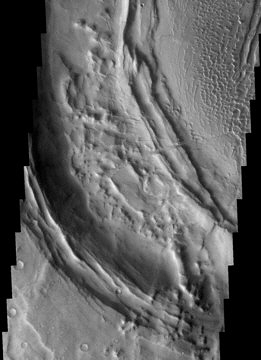
This image from NASA's Mars Odyssey spacecraft shows part of the rim of Nili Patera, the northern caldera of a large volcanic complex in Syrtis Major as well as sand dunes within. The view was recorded by the craft's Thermal Emission Imaging System (THEMIS) instrument. Image courtesy of NASA/JPL/Arizona State University
El Segundo-based SpaceX announced that the maiden flight of its Falcon 1 rocket is scheduled for November 25 at 13:00 PST. The two-stage, liquid-fueled vehicle will lift-off from Kwajalein Atoll and insert the Air Force Academy's FalconSat-2 spacecraft into a 400 x 500 km orbit inclined 39 degrees to the equator.
After reaching orbit, the satellite will measure space plasma phenomena, which can affect space-based communications such as GPS.
According to SpaceX, the Falcon 1 is priced at $6.7 million and will provide the lowest cost per flight to orbit of any launch vehicle.
(NOV 18) NASA's Mars Reconnaissance Orbiter successfully performed a trajectory correction maneuver on Friday. The approximately 20-second burn by six engines increased the spacecraft's speed by less than two miles per hour. The maneuver was the third of four planned adjustments intended to place the probe at the right point in space for its March 10, 2006 arrival at Mars.
After achieving orbit around the planet, the Mars Reconnaissance Orbiter will study martian water distribution, geology, and minerals. The mission is managed by JPL for NASA's Science Mission Directorate.
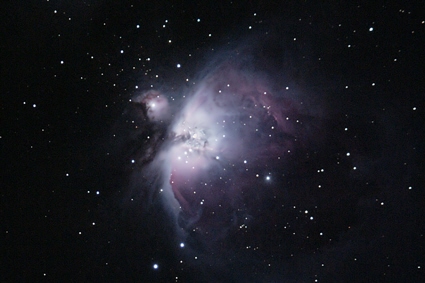
Despite the presence of bright moonlight, this view of the Orion Nebula by Ginger Mayfield of Colorado reveals extensive faint detail. Mayfield created the original image by stacking multiple photos taken with an 85mm refractor and digital SLR. Copyright 2005, Ginger Mayfield
(NOV 11) Two free public programs in Pasadena will offer an overview of the upcoming NASA mission to Pluto. Pluto is the only planet in our solar system not yet studied by a robotic explorer, but not for long.
Dr. Bonnie Buratti, a New Horizons science team co-investigator from NASA's Jet Propulsion Laboratory, Pasadena, Calif., will talk about the mission on Thursday evening, Nov. 17, at JPL and on Friday evening, Nov. 18, at Pasadena City College.
Now at the NASA Kennedy Space Center in Florida, the spacecraft is scheduled for launch on Jan. 11, 2006. JPL will provide the communications coverage for the mission via NASA's Deep Space Network.
NASA's New Horizons mission will be the first to visit Pluto and its largest moon, Charon. The compact spacecraft carries seven science instruments for examining the geology, composition, surface, temperature and atmospheric structure of the planet and its main moon. The science team is studying whether New Horizons will be able to obtain data on the two recently discovered smaller moons of Pluto. The Johns Hopkins Applied Physics Laboratory in Laurel, Md., manages the mission and will operate the spacecraft for NASA.
Both lectures will begin at 7 p.m. Seating is first-come, first-served. The Thursday lecture will be in JPL's von Karman Auditorium. JPL is at 4800 Oak Grove Dr., off the Oak Grove Drive exit of the 210 (Foothill) Freeway. The Friday lecture will be in Pasadena City College's Vosloh Forum, 1570 E. Colorado Blvd. For more information, call (818) 354-0112.
Thursday's lecture will be webcast live at http://www.jpl.nasa.gov/events/lectures/nov05.cfm.
Adapted from a Jet Propulsion Laboratory news release
(NOV 10) Nearly every year for more than a decade, University of Arizona professors, graduate students, or alumni been part of a search for pieces of asteroids, the moon and Mars which have landed on the whitest place on Earth. More

The Sand Hills, the largest sand dune formation in America, is visible in this image from the ASTER instrument on NASA's Terra spacecraft. The dunes cover about a quarter of Nebraska and formed from glacial outwash eroded from the Rocky Mountains and stabilized by vegetation. ASTER is managed by the Jet Propulsion Laboratory and Japan's Earth Remote Sensing Data Analysis Center. Image courtesy of NASA/GSFC/METI/ERSDAC/JAROS, and U.S./Japan ASTER Science Team
(NOV 1) WAUKESHA, WI - As twilight fades on these autumn evenings, a fiery beacon gleams low in the eastern sky. This brilliant orange "star" is actually the planet Mars, and it appears brighter in the next few weeks than it will again until 2018.
Mars reaches its peak appearance from the end of October through November 10. Two dates stand out in particular: On October 29, Mars came closest to Earth. At 11 p.m. EDT that evening, the Red Planet was 43.1 million miles (69.4 million kilometers) from Earth. Then, the night of November 6/7, Mars lies opposite the Sun and remains visible all night.
Although astronomers point to these two dates, anyone looking to the sky throughout this 2-week period will be impressed. Mars shines brighter than any other point of light in the sky once Venus dips below the southwestern horizon. And each evening, the Red Planet climbs a bit higher in the sky.
Mars also impresses with the company it keeps. Look to the left of the planet and you should see a tight group of stars. This is the Pleiades star cluster, sometimes called the Seven Sisters, the brightest such group in the sky. The Pleiades appears best through binoculars, which reveal dozens of stars.
For backyard observers with a telescope, now is the time to view Mars. The planet looms larger in the eyepiece than at any time since its historic appearance in August 2003. However, for Northern Hemisphere observers, the planet stands 30° higher than it did 2 years ago. The greater altitude means light from Mars travels through less of Earth's turbulent atmosphere, so the views of Mars should be as crisp as they were in 2003.
As you gaze at Mars, remember that scientists have sent emissaries from Earth to explore it. For the past 21 months, two rovers have been roaming the planet's surface. Spirit and Opportunity yielded the first ironclad proof that water once flowed across Mars.
Fast facts about Mars:
(NOV 1) New Mexico State University's Department of Astronomy will hold an open house at the campus observatory starting at 7 p.m. Friday, Nov. 11.
Weather permitting, participants will observe the moon, the planet Mars, the Double Cluster, Globular Cluster M15 and the Lyra constellation.
Astronomy personnel on hand will be faculty member Jon Holtzman and graduate students Bhasker Moorthy, Tanya Tavenner and Brandon Lawton.
The Tombaugh Observatory is located east of Williams Avenue, near the running track. Admission is free and children are welcome. The domes are not heated, so dress according to the weather.
For more information call the astronomy department at (505) 646-4438.
Information courtesy of New Mexico State University
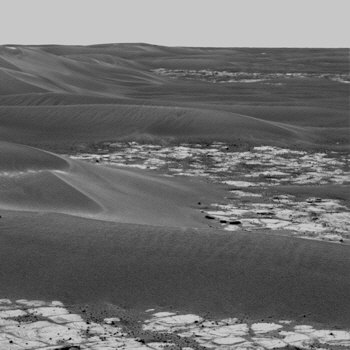
This October 9 image taken by NASA's Mars Exploration Rover Opportunity is a portion of a mosaic acquired by the panoramic camera. The picture highlights the light-toned outcrop on the rim of "Erebus Crater" and large, dark, wind-deposited drifts that have filled the center of the crater. The rover is driving west, avoiding the large drifts and crossing the low ripples and outcrop to the right. Image courtesy of NASA/JPL-Caltech/Cornell
(OCT 27) The University of Arizona Steward Observatory Mirror Lab's casting of the first mirror for the Giant Magellan Telescope (GMT) "appears to be essentially perfect," UA Steward Observatory Director Peter Strittmatter said after astronomers got their first look at the glass last Friday.
The mirror is the first of seven 8.4-meter (27-foot) mirrors that the Mirror Lab is making for the Giant Magellan Telescope. The GMT is the world's first extremely large ground-based telescope to start construction.
The colossal telescope will feature six giant off-axis mirrors around a seventh on-axis mirror. This arrangement will give it a 22-meter (72-foot) aperture, or 4.5 times the collecting area of any current optical telescope. It will have the resolving power of a 24.5-meter (80-foot) diameter telescope, or 10 times the resolution of the Hubble Space Telescope. The GMT is slated for completion in 2016 at a site in northern Chile.
For the casting last July, Mirror Lab workers used 40,000 pounds of Ohara E-6 borosilicate glass. The furnace hit peak temperature, 2,150 degrees Fahrenheit (1,178 Celsius) on July 23. As the furnace rotated at 5 revolutions per minute, glass melted around the 1,681 hexagonal cores in the mold. This created a 'honeycomb' mirror blank with a faceplate of the desired curvature. The honeycomb mirror weighs only a fifth as much as would a solid mirror of the same size.
Adapted from a University of Arizona news release
(OCT 26) VANDENBERG AIR FORCE BASE, Calif. - The 30th Space Wing activates a new squadron, the 30th Launch Support Squadron, in a ceremony Friday. The new unit replaces the 2nd Space Launch Squadron, the squadron formerly responsible for Titan operations. The 30 LCSS will be responsible for factory-to-flight payload processing support, training, and management of launch infrastructure.
"The activation of this squadron from the Mighty 2nd SLS will continue 40 years of heritage launch system success to the next generation of launch vehicles," said Lt. Col. Regis Baldauff who will become the unit's first commander. "The squadron will provide satellite mission assurance and is composed of Air Force Space Command's worldclass professionals, in partnership with industry, providing superior spacelift support from the world's finest facilities."
Adapted from a Vandenberg AFB news release
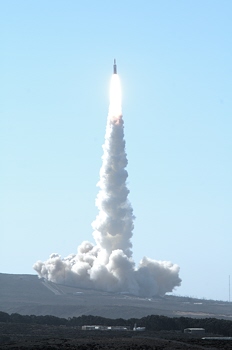
The U.S. Air Force and Lockheed Martin ended the Titan IV program by launching the final booster on October 19th. The rocket lifted-off from Vandenberg AFB at 11:05 PDT and carried a classified payload into orbit for the National Reconnaissance Office. Although the launch took place in daylight, the event was seen as far away as Reno-Sparks, Nevada. Copyright 2005 Brian Webb.
(OCT 23) Just days before its closest approach to Earth, a major dust storm has developed on Mars. The storm erupted about six days ago in the Chryse area and is reportedly growing very quickly.
Veteran planetary imager Don Parker told Space Archive that as of Friday, the storm was centered on central meridian (CM) 45° degrees and covered an area of 2500 by 2500 miles. He said that the conditions on Mars are right for a major dust storm and we should know in a couple of days if the storm will become global.
For a detailed view of the event, you will need a good telescope. According to Parker, a scope as small as 6 inches should suffice - perhaps smaller if you are an experienced observer. He recommends using a magnification of at least 250X and a light red or orange filter.
Assuming the phenomenon does not become global and remains centered on CM 45°, the middle of the storm will cross the Martian disk at the following times:
| Date | PDT | UTC |
|---|---|---|
| OCT 24 | 01:55 | 08:55 |
| OCT 25 | 02:35 | 09:35 |
| OCT 26 | 03:10 | 10:10 |
| OCT 27 | 03:45 | 10:45 |
| OCT 28 | 04:20 | 11:20 |
| OCT 29 | 04:57 | 11:57 |
If you do not have access to a telescope, you may be able to monitor the storm using the unaided eye or a camera.
In 2001 the Earth and Mars had a similar close approach. Over the course of several days, a dust storm appeared and shrouded the entire planet. Using only the naked eye, the webmaster saw Mars' color change from rusty orange to beige.
You may also be able to record Martian color changes due to the dust storm with your digital or film camera. Use an ISO setting of 100 to 200 or a similar speed film. Mount the camera on a tripod, aim it at the Red Planet, open the lens' aperture to f/2.8 to f/4, and make a series of 30, 60, and 90-second exposures.
Take an identical set of photos several days apart. The resulting images will contain Mars trails caused by the Earth's rotation and may reveal Martian color changes.
Of course, if you are a beginning observer, you will you need to know where to look. The planet resembles a bright orange-yellow "star" and rises in the east at approximately 19:10 PDT. It is visible all night as it crosses the sky and is favorably placed for observation in the west at dawn.
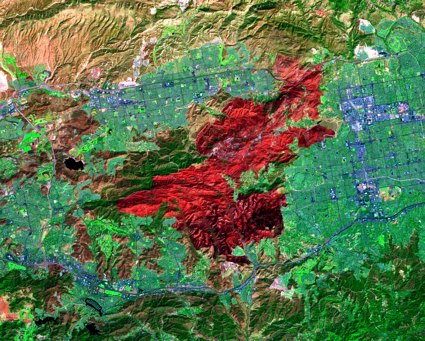
This image from NASA's Terra satellite shows the aftermath of the recent Topanga fire northwest of Los Angeles. The blaze grew to more than 23,000 acres, threatened homes, natural resources, power lines, and communications equipment. The burn area is bright red. This view was captured October 6 by the spacecraft's ASTER instrument. Image courtesy of NASA/GSFC/METI/ERSDAC/JAROS, and U.S./Japan ASTER Science Team
(OCT 14) VANDENBERG AIR FORCE BASE, Calif. - The United States Air Force and Lockheed Martin will launch the final Titan IV B rocket carrying a national security payload for the National Reconnaissance Office (NRO) from here Oct. 19. The launch will take place between 9 a.m. and 1 p.m.
"This will be a historic day for Vandenberg Air Force Base and the Central Coast of California," said Col. Jack Weinstein, 30th Space Wing commander. "The Titan program has been critically important for our nation and we are fortunate to be able to close out this chapter with a final launch of this important system. Even as we bid farewell to the Titan IV, we are very excited as we look forward to our first launches of the new Evolved Expendable Launch Vehicles from Vandenberg."
This will be the 12th Titan IV launch from Vandenberg and the 39th for the United States. In 1986, the Titan IV was developed by Lockheed Martin as the booster used to launch the nation's largest, heaviest and most critical payloads. Titan's initial IV A design was followed by Titan IV B with a new generation of large solid rocket motors, state-of-the-art guidance and electronics and a new ground processing system.
Information courtesy of Vandenberg AFB
(OCT 11) WAUKESHA, WI - October 17th brings the Moon into Earth's shadow for a partial lunar eclipse over North America. This event is a "partial" eclipse because only 7 percent of the Moon dips into the umbra, the darkest part of the shadow. But the entire face of the Moon will pass through the lighter penumbra and turn a dark gray - an eerie sight just 2 weeks before Halloween!
A lunar eclipse occurs when the Sun, Earth, and Full Moon align in that order. Viewers can expect to see a bite taken out of the Full Moon's southern limb, while the rest of the disk takes on a more grayish hue than normal.
On the 17th, the eclipse starts at 5:51 a.m. EDT (2:51 a.m. PDT). It will take 4 hours and 24 minutes for the Moon to pass through the shadow completely. Viewers in eastern North America will see only the early phases of the eclipse.
The eclipse will be easy to see with your naked eyes, but try using binoculars or a telescope for close-up looks at the Moon's dark, flat maria, or "seas," and light craters. Our satellite is a great - and easy - object to observe, even from a brightly lit city.
The next time North Americans will see a lunar eclipse will be March 14, 2006.
| Eclipse begins | 2:51 a.m. PDT |
| Umbral eclipse begins | 4:34 a.m. PDT |
| Mideclipse | 5:03 a.m. PDT |
| Umbral eclipse ends | 5:32 a.m. PDT |
| Eclipse ends | 7:15 a.m. PDT |
Information courtesy of Astronomy Magazine
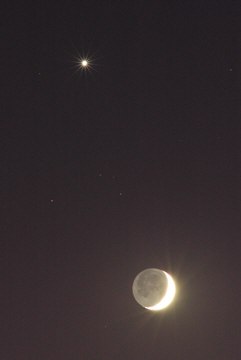
A conjunction of the Moon and Venus last Thursday provided a fine display for skywatchers and laymen alike. The webmaster captured this image of the event while testing a new telephoto lens. Copyright 2005, Brian Webb
(OCT 9) A faint star will perform a disappearing act this Wednesday for suitably equipped observers across much of North America. On the evening of October 12th, the Moon's eastward orbit will carry it in front of +4.8 magnitude kappa Capricorni, hiding the star from view.
Optical assistance such as tripod mounted binoculars or a telescope will probably be needed to see the event due to the star's faintness and proximity to the much brighter Moon. The disappearance and reappearance times for selected locations are as follows:
| Location | Disappears (PDT) |
Reappears (PDT) |
|---|---|---|
| San Francisco | 21:25:51 | 22:41:28 |
| Los Angeles | 21:29:54 | 22:45:33 |
| Reno | 21:31:06 | 22:45:29 |
| Salt Lake City | 21:43:09 | 22:54:34 |
| Albuquerque | 21:51:11 | 22:54:50 |
| Denver | 21:53:36 | 22:59:02 |
(OCT 4) Tomorrow's launch attempt of the U.S. Air Force Evolved Expendable Launch Vehicle program mission NROL-22, a National Reconnaissance Office payload scheduled for launch aboard a Boeing Delta IV rocket from Vandenberg AFB., Calif., is being delayed. The launch teams identified a potential concern involving predictions of propellant sloshing during the coast phase of the launch vehicle's second stage. Propellant sloshing refers to the movement activity of propellant inside the fuel tank during flight. The launch teams are conducting a precautionary technical review and mission analysis to rule out the concern before proceeding with the launch. Upon completion of the review, a new launch date will be determined.
The launch teams have successfully concluded the cork-bonded insulation work on the launch vehicle's thermal shield.
Information courtesy of Vandenberg AFB
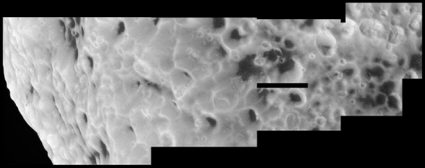
This high-resolution mosaic, composed of images taken during Cassini's close flyby of Hyperion on September 26, reveals that Hyperion has a surface unlike that of any of Saturn's other moons. Scientists are extremely curious to learn what the dark material is that fills many craters on this moon. Image courtesy of NASA/JPL/Space Science Institute
(OCT 2) The launch of the U.S. Air Force Evolved Expendable Launch Vehicle program mission NROL-22, a National Reconnaissance Office payload to be launched aboard a Boeing Delta IV rocket from Vandenberg AFB, Calif., is being delayed to no earlier than Oct. 5. The launch team is performing additional testing to the cork-bonded insulation on the composite thermal shield structure located at the base of the rocket. The cork protects the composite thermal shield from hot gases generated by the rocket's main engine during flight. Upon completion of the work, a launch date will be confirmed.
Adapted from a Boeing news update
(SEP 30) Vandenberg Air Force Base, Calif. - Vandenberg AFB is set to conduct the inaugural West Coast launch of a Boeing Delta IV rocket Monday. The launch will take place between 3 and 5 p.m. The rocket will carry a national security payload for the National Reconnaissance Office.
Col. Jack Weinstein, 30th Space Wing commander, is the spacelift commander, or final "go for launch" authority, for this mission. The 30th Space Wing is the Air Force Space Command organization responsible for all Department of Defense space and missile launch activities on the West Coast of the United States. All U.S. satellites destined for near polar orbit are launched from Vandenberg.
Monday's Delta IV launch will use the medium+ configuration of the booster's five design options, which enable it to place payloads in orbit ranging from nearly 9,000 pounds to more than 27,000 pounds.
Adapted from a Vandenberg AFB news release
(SEP 27) New Mexico State University's Department of Astronomy will hold an open house at the campus observatory at 7 p.m. Friday, Oct. 7.
Weather permitting, participants will observe the moon, the Lagoon nebula, the Ring nebula, the globular clusters M15 and M32, and the Andromeda galaxy. Astronomy personnel on hand will be faculty member Anatoly Klypin and graduate students Steven Nelli, Joe Helmboldt and Jillian Bornak.
The observatory is located off of Williams Avenue, between Stewart Street and Wells Street. Admission is free and children are welcome. The domes are not heated, so dress accordingly.
For more information call the astronomy department at (505) 646-4438.
Information courtesy of New Mexico State University
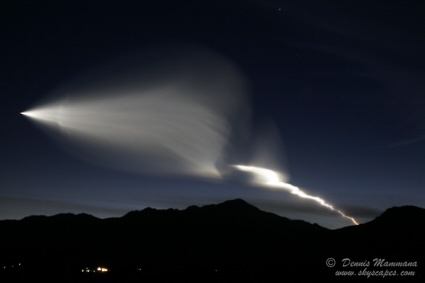
A dusk rocket launch from Vandenberg AFB on September 22 created an impressive display that was seen across a wide area. Astronomy author and photographer Dennis Mammana took this image during the third stage burn. In addition to the third stage exhaust plume (left), the photo also shows the trail from the second stage (right) and the break in the trail from stage 2/3 separation. The Minotaur rocket successfully placed the Streak satellite into orbit for the Defense Department. Image used with permission.
(SEP 22) Mars is now among the brightest object in the night sky. Over the next five weeks the Earth will close in on Mars, causing the Red Planet to double in brightness. More
(SEP 19) VANDENBERG AIR FORCE BASE, Calif. - Team Vandenberg is set to launch a Minotaur rocket Thursday from Space Launch Complex-8 on South Vandenberg. The launch period is from 7:24 to 7:40 p.m. The rocket will launch the Defense Advanced Research Projects Agency's Streak spacecraft.
30th Space Wing Commander Col. Jack Weinstein will be the spacelift commander, or final "go for launch" authority, for Thursday's launch.
The Minotaur rocket is a ground-based variant of the Orbital Sciences Corp. air-launched Pegasus rocket. It is capable of launching up to 3,000 pounds into a low-Earth orbit and up to 800 pounds into geosynchronous transfer orbit.
Information courtesy of U.S. Air Force
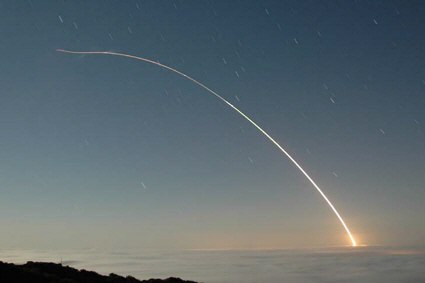
A Minuteman III ICBM heads downrange in this September 14 time exposure by Brian Lockett. The ICBM was launched from north Vandenberg at 01:01 PDT and sent one unarmed reentry vehicle 4,800 miles to its target at Kwajalein in the Marshall Islands. Copyright 2005, Brian Lockett. Used with permission
(SEP 15) Two NASA satellites, planned for launch no earlier than Oct. 26, will give us a unique view of Earth's atmosphere. CloudSat and Cloud-Aerosol Lidar and Infrared Pathfinder Satellite Observations (Calipso) are undergoing final preparations for launch from Vandenberg Air Force Base, Calif. More
(SEP 12) VANDENBERG AIR FORCE BASE, Calif. - An unarmed Minuteman III intercontinental ballistic missile is scheduled to launch from North Vandenberg Wednesday morning. More

Although the breaches in the levees had been sealed, New Orleans was still under a deep blue blanket of water in this September 6 image. A strip of the city along the banks of the Mississippi River, which includes downtown and the French Quarter, remained dry. The view was captured by the Advanced Land Imager on NASA's EO-1 satellite. EO-1 was launched from Vandenberg AFB in 2000. Image courtesy of NASA GSFC
(SEP 7) A very active sunspot group numbered by NOAA as Region 808, is currently rotating onto the visible side of the Sun. This sunspot cluster, formally numbered as Region 798 was responsible for significant solar activity during its previous transit on the visible solar disk, and continued to produce significant eruptions during its passage on the far side of the Sun. Current solar imagery indicates that this region is still very active, and will become visible from Earth today. Solar flares producing significant radio blackouts, and radiation storms are likely from this active region. Geomagnetic storms are possible later this week as this sunspot group rotates towards the center of the visible solar disk.
Agencies impacted by space weather storms may experience disruptions over the next two weeks. These include spacecraft operations, electric power systems, HF communication, and navigation systems. Users of HF communications and low-frequency navigation systems will be particularly vulnerable during the next three days.
Information courtesy of NOAA Space Environment Center
(SEP 7) An unarmed Minuteman III missile was launched from North Vandenberg this morning at 01:53 PDT. The mission tested the reliability and accuracy of the Minuteman III weapon system.
The launch was a team effort by members of Vandenberg's 30th Space Wing and 576th Flight Test Squadron and the 91st Space Wing from Minot AFB, N.D. Missile combat crewmembers deployed to Vandenberg from the 91st Space Wing issued the final launch command.
The 576th FLTS performed maintenance activities including missile emplacement and the installation of unique missile tracking, telemetry and command destruct systems to collect test data and meet safety requirements.
The missile's two unarmed re-entry vehicles traveled approximately 4,200 nautical miles in about 30 minutes, hitting pre-determined targets at Kwajalein Atoll in the western chain of the Marshall Islands.
Adapted from a Vandenberg AFB news release
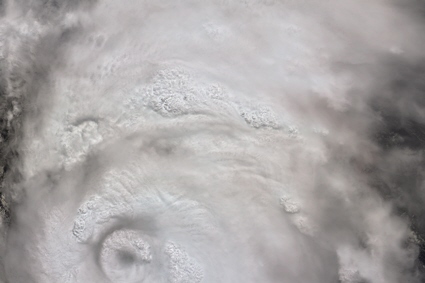
This portion of an image from the Multi-angle Imaging Spectro-radiometer (MISR) on NASA's Terra spacecraft show the strong convective development of Hurricane Katrina on Saturday, August 27, as it moved west through the Gulf of Mexico. At that time, Katrina was undergoing rapid development and had just been upgraded to a Category 3 hurricane. MISR was built and is managed by the Jet Propulsion Laboratory. Image courtesy of NASA/GSFC/LaRC/JPL, MISR Team
(SEP 2) VANDENBERG AIR FORCE BASE, Calif. - An unarmed Minuteman III intercontinental ballistic missile is scheduled to launch from North Vandenberg Wednesday morning. The six-hour launch window is from 1:01 to 7:01 a.m. PST. More
(AUG 30) Mojave, CA: XCOR Aerospace, Inc., announced today that it has successfully completed its first series of tests on a 50 pound thrust rocket engine fueled by methane and liquid oxygen.
Future generations of the 3M9 engine are intended for use as Reaction Control Systems (RCS) and satellite maneuvering systems. The advantages of a methane-fueled engine include long-term on-orbit storage, higher density than hydrogen engines, higher performance than kerosene engines, and the potential for using methane derived from the Martian atmosphere as a fuel source.
The engine tests took place at XCOR's facilities at Mojave Spaceport. The engine tests consisted of 22 engine firings totaling 65 seconds. The longest engine firing was 7 seconds. This first series of tests were done with self-pressurizing propellants. Pressure-fed and pump-fed versions are also in development.
Information courtesy of XCOR Aerospace
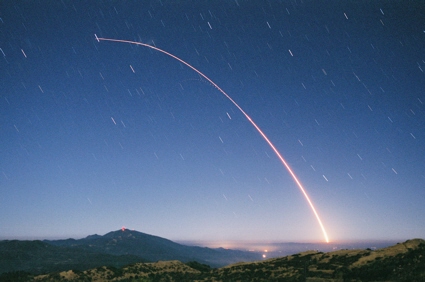
This photo by the webmaster captures the entire visible portion of Thursday morning's Minuteman III launch from Vandenberg AFB. The film-based time exposure was taken from the mountains north of Santa Barbara. Moonlight gives the foreground and sky a surreal quality. The short dashes are star tails caused by the Earth's rotation. Copyright 2005, Brian Webb
(AUG 28) Observers in the Southwest and other areas can enjoy another planetary pairing next week as Jupiter and Venus have an apparent near-miss. The planets will move closer over the next few evenings until their closest approach on September 1.
From Los Angeles, Jupiter and Venus will be separated by less than 1.3° at dusk on Thursday. The pair should be visible to the unaided eye low in the west after sunset for about 90 minutes. At that time, Venus will be to the lower left of the much fainter Jupiter.
(AUG 23) Decades after they flew the X-15 to the edge of space, three civilian test pilots were awarded astronaut wings. The men were honored in a quiet ceremony at NASA's Dryden Flight Research Center on Edwards Air Force Base in California, site of their achievements. More
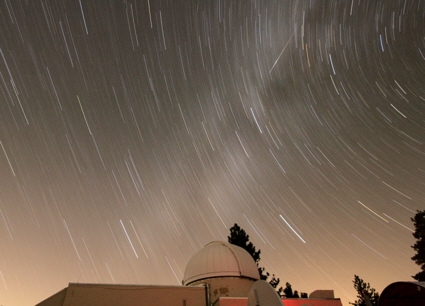
A Perseid meteor streaks over California's Table Mountain Observatory in this image by astronomer James Young. The 35-minute exposure was taken before dawn on August 12th, the peak of the month-long Perseid meteor shower. The faint white cloud is the Milky Way. Image Copyright 2005, James Young. Used with permission.
(AUG 19) An unarmed Minuteman III ICBM is scheduled for launch from Vandenberg AFB on August 25 to test the ability to integrate a different warhead into the existing Minuteman III weapons system. More
(AUG 17) The Planetary Society continues to fund the search for potentially hazardous comets and asteroids that orbit close to our planet by awarding Gene Shoemaker Near Earth Object Grants to five researchers around the world. More
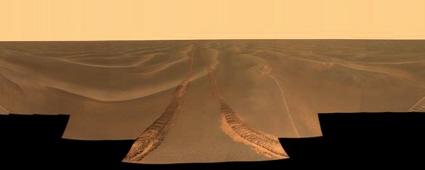
Portion of a panorama acquired by NASA's Mars rover Opportunity at "Purgatory Dune." The rover was stuck in the dune's deep fine sand for more than a month. The deep ruts dug by Opportunity's wheels as it became stuck appear in the foreground. The panorama is named "Rub al Khali" (Arabic for "the empty quarter") after a similarly barren, desolate part of the Saudi Arabia. Image courtesy of NASA/JPL/Cornell
(AUG 12) VANDENBERG AFB, Calif. - The 30th Space Wing supported the re-entry and landing of the NASA Discovery space shuttle at Edwards AFB, Calif. Tuesday through Western Range operations, 76th Helicopter Flight support and emergency landing availability. More
(AUG 9) NASA's Mars Reconnaissance Orbiter (MRO) is ready for a morning launch on Wednesday, Aug. 10. The MRO will arrive at Mars in March 2006 for a mission to understand the planet's water riddles and to advance the exploration of the mysterious red planet. More
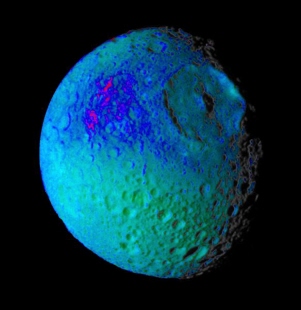
This false color Cassini spacecraft image reveals variations in the composition and texture across Saturn's moon Mimas. The view is a composite of ultraviolet, green, infrared and clear filter images taken on August 2 during Cassini's encounter with the object. The photos were captured with the spacecraft's narrow-angle camera from a range of 142,500 miles (228,000 kilometers). Image courtesy of NASA/JPL/Space Science Institute
(AUG 5) When the first samples of a comet ever returned to Earth arrive next January, the first stop for some of them will be the Advanced Light Source, where a database of extraterrestrial samples is being compiled to chart the chemical history of the solar system. More
(AUG 3) Astronomers have found that the sky glows in very energetic X-rays. They think the X-rays are the last gasp of material being swallowed by massive black holes. More

The lights of Waikiki are only rivaled by the planet Venus (top) in this July 17 dusk photo. The naked eye planet is currently 125 million miles from Earth and visible low in the west after sunset. Copyright 2005, Brian Webb
(JUL 29) PASADENA, Calif.--A planet larger than Pluto has been discovered in the outlying regions of the solar system with the Samuel Oschin Telescope at Palomar Observatory, California Institute of Technology planetary scientist Mike Brown announced today. More
(JUL 28) NASA's Spitzer Space Telescope has found the ingredients for life all the way back to a time when the universe was a mere youngster. More
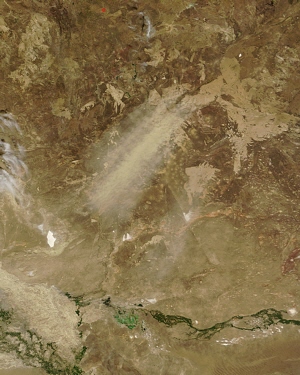
Dust streams to the southwest across Kazakhstan in this image recorded on July 20 by the MODIS instrument on NASA's Terra satellite. The instrument also imaged the Syrdar'ya River at bottom, bright white salt pans, and the myriad shades of brown deserts that stretch across the southern end of the country. Terra was launched from California in 1999. Image courtesy of Jeff Schmaltz, MODIS Land Rapid Response Team, NASA GSFC
(JUL 21) VANDENBERG AIR FORCE BASE, Calif. - An unarmed Minuteman III intercontinental ballistic missile was successfully launched from North Vandenberg at 1:01 a.m. PDT today.
The mission was to demonstrate the ability to integrate new products into the weapon system.
The missile's one unarmed re-entry vehicles traveled approximately 4,200 miles in about 30 minutes, hitting a pre-determined target at the Kwajalein Missile Range in the western chain of the Marshall Islands.
Information courtesy of U.S. Air Force
(JUL 19) VANDENBERG AIR FORCE BASE, Calif. - An unarmed Minuteman III intercontinental ballistic missile is scheduled for launch from North Vandenberg Thursday morning as part of a developmental test to demonstrate the ability to integrate a Safety Enhanced Re-entry Vehicle into the Minuteman III weapons system. More
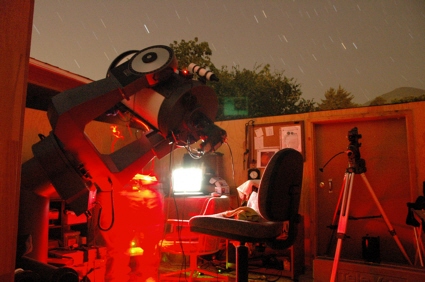
Comet expert Charles Morris (ghostly figure) checks his telescope on the evening of July 3 prior to the collision of NASA's Deep Impact and comet Tempel 1. Morris collected pre- and post-impact images from his private observatory in Ventura County, California. Copyright 2005, Brian Webb
(JUL 10) On the evening of July 17 observers can watch the Moon pass in front of (occult) the bright star Antares. As seen from Los Angeles, the star disappears at 20:14 and reappear at 21:09 PDT (these times can vary significantly depending on your location).
Although Antares is one of the brightest stars in the sky and easily visible to the naked eye, it will be overpowered by the Moon's glare during this event and difficult to see. For the best view of the occultation, use binoculars or a small telescope.
(JUL 6) Scientists using data from satellites launched from Vandenberg AFB and ground-based measurements observed a burst of high altitude cloud activity over Antarctica in 2003 due to the exhaust plume of the space shuttle Columbia during its final flight. The data call into question the role these clouds may play in monitoring global climate change. More
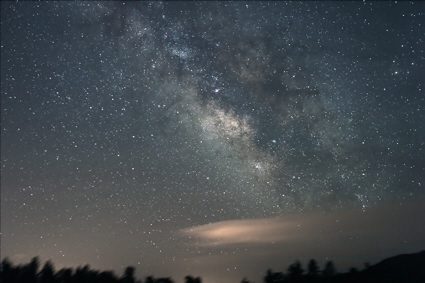
The summer Milky Way is arguably the night sky's most impressive feature. When seen from dark sites, it resembles a swath of light and stars stretching from horizon to horizon. Astroimager Ginger Mayfield recently took six guided time exposures of the Milky Way with her Canon EOS 10D digital camera near Lake George, Colorado and combined them to produce this view. Copyright 2005, Ginger Mayfield
(JUL 1) NASA's Deep Impact spacecraft continues to close in on comet Tempel 1. Late Saturday the probe will release a 39-inch-wide impactor into the path of comet. On July 3 at 22:52 PDT (▒3 minutes) Earth-receive time, the impactor should hit its target. More
(JUN 27) The University of Arizona's Steward Observatory Mirror Lab is pre-firing its huge spinning furnace and inspecting tons of glass for casting a first 8.4-meter (27-foot) diameter mirror for the Giant Magellan Telescope (GMT). The casting is scheduled for Saturday, July 23. More
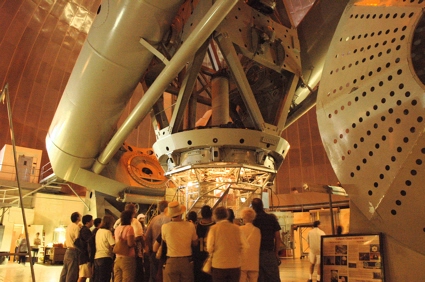
Visitors behold the 200-inch Hale Telescope as a guide describes the massive instrument. The insider's tour of the telescope was one of several activities offered to the public during the Palomar Observatory open house on June 25. Image Copyright 2005, Brian Webb
(JUN 26) During dusk on June 27, observers in the Southwest can enjoy a close grouping of three naked eye planets low in the west. Venus and Mercury be separated by approximately 0.15°. Saturn will lie about 2.5° below the pair.
To spot this planetary trio, locate Venus about 30 minutes after sunset. Mercury and Saturn will be much fainter and be to Venus' left and lower right, respectively.
(JUN 22) Cosmos 1, the first solar sail spacecraft, was launched on June 21 at 12:46 PDT from a submerged Russian submarine in the Barents Sea. The Russian space agency has tentatively concluded that the Volna rocket carrying Cosmos 1 failed during the firing of the first stage. This would mean that Cosmos 1 is lost.
However, the Cosmos 1 team observed what appear to be signals from the spacecraft when it was over the first three ground stations and some Doppler data over one of these stations.
This might indicate that Cosmos 1 achieved orbit, but probably a lower one than intended. Although the project team considers this to be a very small probability, efforts to contact and track the spacecraft continue.
Information courtesy of the Planetary Society
(JUN 20) On June 21, 2005, Cosmos 1, a project of The Planetary Society and Cosmos Studios, is launching a breakthrough mission to assist the world community in developing future solar sail technologies. Four days after launch, the spacecraft will deploy its eight silver sails and become one of the brightest objects crossing the night sky. More
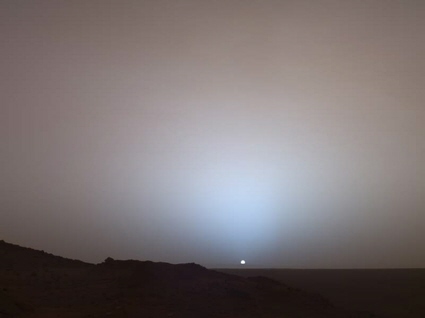
NASA's Mars Exploration Rover Spirit captured this view as the Sun set on the rim of Gusev crater on May 19th. The Sun appears only about two-thirds as large as seen from Earth because Mars is farther from the Sun. Sunset and twilight images are occasionally acquired to determine how high martian dust extends into the atmosphere and to look for dust or ice clouds. Image courtesy of NASA/JPL/Texas A&M/Cornell
(JUN 13) BERKELEY - The world's preeminent planet hunters have discovered the most Earth-like extrasolar planet yet: a possibly rocky world about 7.5 times as massive as the Earth.
This hot "super-Earth," just 15 light years away, travels in a nearly circular orbit only 2 million miles from its parent star, Gliese 876, and has a radius about twice that of Earth. More
(JUN 13) VANDENBERG AFB, Calif. - The Defense Meteorological Satellite Program (DMSP) F-17 Block 5D-3 spacecraft, built under contract for the U.S. Air Force by Lockheed Martin Space Systems Company, Sunnyvale, Calif., has been delivered to Vandenberg Air Force Base, Calif., in preparation for a December 2005 launch. More
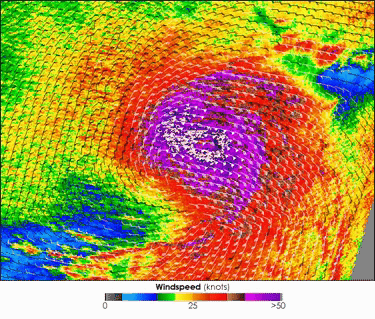
The near-surface winds generated by Typhoon Nesat are revealed in this QuickSCAT satellite image taken on June 6. At that time the storm was over the Philippine Sea and had winds of 132 miles (213 kilometers) per hour. The spacecraft recorded the winds by bouncing microwave energy off of the wind-roughened ocean surface. QuickSCAT was launched from Vandenberg AFB in 1999. Image courtesy of JPL QuickSCAT Science Team
(JUN 7) Weather permitting, suitably equipped observers can view a dual shadow transit on Jupiter this Thursday night. The shadows of planet's moons Io and Europa will cross Jupiter's disk on June 9-10 beginning at 22:29 PDT. For the next two hours, the shadows will move in close formation across the giant planet's cloud tops.
The event should easily be visible through a moderate-sized telescope with the shadows resembling two ink-black dots. Keen-eyed observers may also see Io passing in front of Jupiter's disk during the early portions of the shadow transit.
(JUN 6) VANDENBERG AIR FORCE BASE, Calif., June 6, 2005 - Lockheed Martin's new West Coast Atlas V facility passed its first major operational event with a successful propellant loading test June 2. More
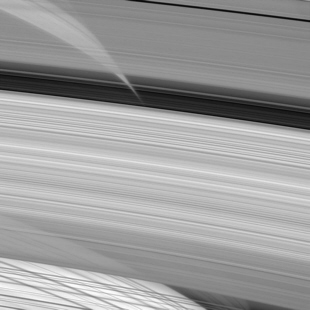
This impressive Cassini spacecraft image looks through Saturn's A, B, and C rings (from bottom to top) and shows the shadows of the same rings on the planet's atmosphere. The image was taken in visible light by the spacecraft's narrow-angle camera from a distance of approximately 1.4 million miles (2.3 million kilometers). Image courtesy of NASA/JPL/Space Science Institute
(JUN 5) From Moscow to the Marshall Islands, from California to the Czech Republic, tracking stations around the world will receive data from Cosmos 1, the world's first solar sail spacecraft, after it launches on June 21, 2005. More
(JUN 1) Vandenberg Air Force Base, Calif. - The scheduled launch of an unarmed Minuteman III intercontinental ballistic missile was aborted due to abnormal indications received during terminal countdown. The 595th Space Group Launch Anomaly Group is investigating the cause of the abort and more details will be released as they become available. The launch has not yet been rescheduled.
Information courtesy of U.S. Air Force
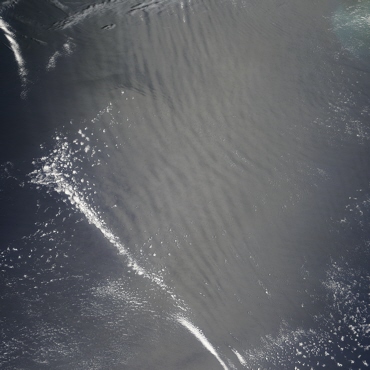
NASA's Terra satellite captured this image on May 23 of a large-scale, overlapping pattern on the Arabian Sea caused by atmospheric gravity waves.
Gravity waves form when buoyancy pushes air up and gravity pulls it back down. On its descent into the low-point of the wave, the air touches the surface of the ocean, roughening the water and creating the dark lines seen here. Terra was launched from California in 1999. Image courtesy of MODIS Rapid Response Project
(MAY 29) For the second time this month, a bright solar system object will have a close brush with Uranus. The Moon's eastward orbit will carry it a few degrees south of the planet on the morning of May 30 with closest approach occurring at about 05:31 PDT (12:31 UTC).
Using little more than binoculars, observers on the West Coast can get a view of the celestial pairing just before the start of morning twilight. As seen from Los Angeles, +5.8 magnitude Uranus will be 3.9° from the Moon's 10 o'clock position at 04:00 PDT (11:00 UTC).
(MAY 24) NASA's Voyager 1 spacecraft has entered the solar system's final frontier. It is entering a vast, turbulent expanse where the Sun's influence ends and the solar wind crashes into the thin gas between stars. More
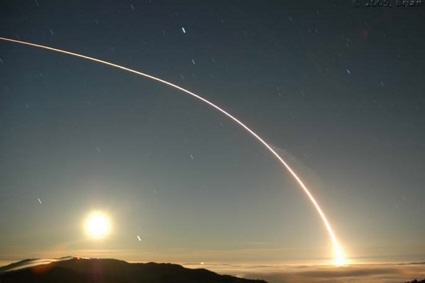
After several delays, a Delta II rocket carrying the NOAA-N environmental satellite lifted-off from Vandenberg AFB on May 20 at 03:22 PDT. This time exposure taken from the mountains northwest of Santa Barbara by Brian Lockett shows the Delta's arc-shaped flight path as well as coastal low clouds illuminated by the setting Moon (the bright orb near the horizon). Image Copyright 2005, Brian Lockett. Used with permission
(MAY 20) A NASA satellite that measures the variability in the amount of the Sun's energy that reaches Earth's atmosphere and impacts our winds, land and oceans has successfully accomplished its five-year primary mission. More
(MAY 16) A NASA spacecraft designed to reveal the inner secrets of Earth's clouds has arrived at Vandenberg Air Force Base, Calif., to begin final launch preparations. More
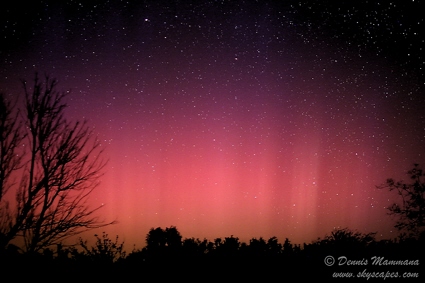
Contrary to popular belief, the Northern Lights are sometimes visible from southern California. Dennis Mammana was returning to his home in Borrego Springs early on the morning of May 15 when he noticed a diffuse glow in the north. After confirming an aurora was under way, Mammana went outside and began shooting. He took multiple photos including this 15-second exposure at 01:41 PDT. Image Copyright 2005, Dennis Mammana. Used with permission
(MAY 14) This morning's launch of the NOAA-N environmental satellite from Vandenberg AFB was cancelled late Friday. A Boeing media advisory explained the reason for the action:
"During de-tanking of RP-1 propellant after the launch attempt on Thursday, a vent hose in the launch vehicle's intertank area broke loose. The potential that hydrocarbons may have entered the payload fairing is being determined. Samples must be taken from NOAA-N to assure that hydrocarbons, if present, have not exceeded the spacecraft's allowable limits."
The Air Force said the launch has been rescheduled for the morning of May 20 at 03:22 PDT.
(MAY 13) ST. LOUIS - Boeing and NASA scrubbed today's launch attempt of the National Oceanic and Atmospheric Administration satellite, NOAA-N, aboard a Boeing Delta II rocket from Vandenberg Air Force Base, Calif.
One of four water deluge system pumps located in a facility near the launch pad failed during the countdown. The launch team was unable to identify the cause of the failure and resolve the issue in time to meet the 10-minute window at 3:22 a.m. PDT.
The next launch attempt is scheduled for May 14, with the same 10-minute window opening at 3:22 a.m. PDT, pending resolution of the issue.
Information courtesy of Boeing
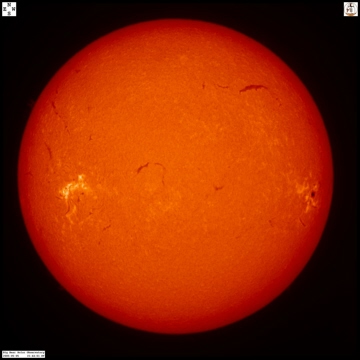
Abundant detail is visible in this Big Bear Solar Observatory view of the Sun taken May 5. The image was recorded in hydrogen alpha light at 08:44 PDT (15:44 UTC) with a 2032 x 2032 pixel Apogee KX4 CCD camera. Image courtesy of Big Bear Solar Observatory/New Jersey Institute of Technology
(MAY 8) Early risers have a chance to see a planetary pairing and spot an outer planet this Saturday morning. Earth's neighbor Mars and the distant planet Uranus will be separated by 1.2° as they rise on May 14.
Mars will shine brightly at magnitude +0.5 and be easily visible to the naked eye. In contrast, Uranus will be much fainter - magnitude + 5.8 - and will only be visible to the unaided eye from very dark locations.
To spot this pairing, observers in the Southwest should look low in the east about 90 minutes before sunrise. Locate orange-red Mars which will be about 20 degrees above the horizon. Using binoculars or a small telescope, look for the much fainter Uranus at the 10 o'clock position with respect to Mars. The full Moon is about 1/2° in diameter. The two planets will be separated by roughly double that amount.
(MAY 4) NASA is set to launch the new National Oceanic and Atmospheric Administration (NOAA) Polar-orbiting Operational Environmental Satellite (POES), another critical link in the development of a global Earth-observation program.
The spacecraft, NOAA-N, will lift off at 6:22 a.m. EDT, May 11, 2005, from Vandenberg Air Force Base, Calif. More
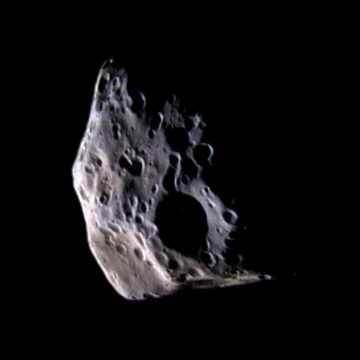
This false color Cassini image provides the closest view thus far of Saturn's moon Epimetheus. The slightly reddish feature in the lower left is a crater named Pollux. This view of the 72 mile (116 kilometer) moon is a composite of ultraviolet, polarized green, and infrared images taken by the spacecraft from a distance of 46,350 miles (74,600 kilometers). Image courtesy of NASA/JPL/Space Science Institute
(APR 30) A Minuteman III missile launch scheduled for the morning of Wednesday, April 27 did not occur. The launch was a part of the Force Development Evaluation Program, which tests the reliability and accuracy of the Minuteman III and Peacekeeper weapon systems. An Air Force team is investigating the incident.
(APR 25) VANDENBERG AIR FORCE BASE, Calif. - An unarmed Minuteman III intercontinental ballistic missile is scheduled for launch from North Vandenberg Wednesday morning as part of the Force Development Evaluation Program. The six-hour launch window is from 1:01 a.m. to 7:01 a.m. PST. More
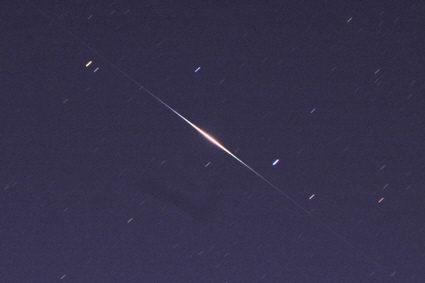
The Iridium 46 satellite creates a bright flare of light as it crosses the dusk sky above southern California on April 10. The spacecraft's brilliance resulted from sunlight reflecting off of its mirror-like surface. The short lines are star trails caused by the Earth's rotation. Iridium 46 was launched aboard a Delta rocket from Vandenberg AFB in August 1997. Copyright 2005, Brian Webb
(APR 20) Scientists have closely examined four Genesis spacecraft collectors, vital to the mission's top science objective, and found them in excellent shape, despite the spacecraft's hard landing last year. More
(APR 20) NASA's Spitzer Space Telescope has spotted what may be the dusty spray of asteroids banging together in a belt that orbits a star like our Sun. The discovery offers astronomers a rare glimpse at a distant star system that resembles our home, and may represent a significant step toward learning if and where other Earths form. More

A ground-based view by Tony Lazar of launch and chase aircraft prior to Friday's airborne launch of a Pegasus XL rocket carrying NASA's DART satellite. An L-1011 jumbo jet carrying the rocket departed Vandenberg AFB and flew up the coast before reaching the launch point 74 miles southwest of Monterey. This view shows the aircraft making a turn offshore of San Mateo about 10 minutes before launch. Lazar said the launch was to his south and barely visible. Copyright 2005, Tony Lazar. Used with Permission
(APR 13) VANDENBERG AIR FORCE BASE, Calif. - NASA's Demonstration of Autonomous Rendezvous Technology (DART) spacecraft is set to launch aboard an Orbital Sciences Pegasus launch vehicle April 15 between 10:21 - 10:28 a.m. PDT.
The Pegasus launches from beneath an L-1011 carrier aircraft, which departs Vandenberg's airfield about one hour before launch. The drop occurs about 100 miles offshore.
DART is planned to demonstrate technology required for spacecraft to rendezvous with other craft without human intervention.
Information courtesy of U.S. Air Force
(APR 13) Barring unfavorable weather, observers in portions of California, Mexico, and Central America can see an occultation of the star Upsilon Geminorum this Friday evening. The Moon's eastward orbit will carry it in front of the +4.1 magnitude star, causing it to disappear behind the Moon's dark limb and later reappear on its sunlit side. More
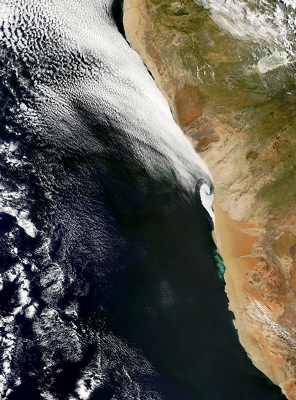
Namibia's spectacular coastline runs for over 930 miles (1,500 kilometers) along southwestern Africa, and is a mosaic of stunningly rich colors and textures. This true-color Terra MODIS image taken April 2 shows the Namib Desert where giant orange sand dunes can stand over 800 feet tall. Off the coast a bright turquoise-blue wash of color in the southern Atlantic Ocean marks a sulfur eruption fed by nutrients in the Benguela Current. Terra was launched from Vandenberg AFB in 1999. Image courtesy of MODIS Rapid Response Project
(APR 7) VANDENBERG AIR FORCE BASE, Calif. - Team Vandenberg is set to launch a Minotaur rocket Monday from Space Launch Complex-8 on South Vandenberg. The launch window is from 6:34 a.m. to 7 a.m. More
(APR 4) SACRAMENTO, Calif. -- Aerojet, a GenCorp Inc. (NYSE: GY) company, announced today that it successfully completed a test of its Atlas« V solid rocket motor on a new test fixture at the Air Force Research Laboratory (AFRL), Edwards AFB, Calif. The solid rocket motor test took place on April 1, 2005 at AFRL. More
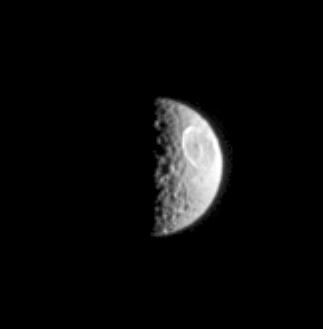
Saturn's moon Mimas shines in reflected ultraviolet light from the Sun in this Cassini image acquired on February 18. UV images of Saturn's moons often reveal the walls of their myriad craters in greater contrast than images taken in visible light. This view, which shows the large impact crater Herschel, is no exception.
Cassini was 583,000 miles (938,000 kilometers) from the 247-mile (397 kilometer) diameter Mimas when it took this photo. Image courtesy of NASA/JPL/Space Science Institute
(APR 3) Saturn's faint moon Iapetus reaches inferior conjunction early next week and will be favorably placed for observation in amateur telescopes. A good time for residents of the Southwest to hunt for the magnitude +11 object is the evening of April 4 at about 21:00 PDT (04:00 UTC).
To spot Iapetus from moderately light polluted locations, use an 8-inch or larger telescope. If you are observing from a darker site, a 6-inch instrument will probably suffice. Experiment with a range of magnifications (160x is a good bet for an 8-inch scope).
Assuming your telescope inverts images and south is at the top, look for Saturn's bright moon Titan in the foreground at the 8 o'clock position about 75 arc seconds from the planet. The much fainter Iapetus should be immediately to right of Titan and slightly below it.
(MAR 31) Using a technique known as quasar absorption line spectroscopy, scientists can analyze the clouds of gases in galaxies between the Earth and a faraway quasar - in essence, taking a "core sample" of the universe through time and space, says New Mexico State University astronomer Chris Churchill. More
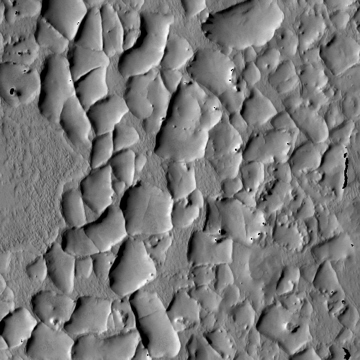
Close-up of a 2001 Mars Odyssey image of polygonal ridges in the martian highlands northwest of Syrtis Major. The ridges are believed to have formed after fractures were filled in with resistant material and erosion removed the less resistant surrounding material. Image courtesy of NASA/JPL/Arizona State University
(MAR 25) Tomorrow morning's Minuteman III launch from Vandenberg AFB has been postponed indefinitely. A new launch date has not been announced.
(MAR 24) This week's launch of a Minuteman III missile from Vandenberg has been rescheduled for the morning of Saturday, March 26. The launch window is from 00:01 to 06:01 PST. The launch was rescheduled to allow adequate time for processing following the previous weather delay.
(MAR 23) VANDENBERG AIR FORCE BASE, Calif. - An unarmed Minuteman III intercontinental ballistic missile is scheduled for launch from North Vandenberg Friday morning as part of the Force Development Evaluation Program. The six-hour launch window is from 12:01 a.m. to 6:01 a.m. PST. The purpose of the launch is to verify the continued reliability and accuracy of the Minuteman III ICBM. More
(MAR 22) Tomorrow morning's launch of a Minuteman III missile from Vandenberg AFB was delayed due to weather related issues. The Air Force has not announced a new launch date, but the webmaster's sources indicate the launch may have been rescheduled for March 25.
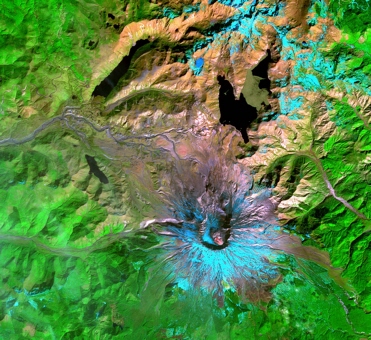
NASA's Terra satellite took this image of Mount St. Helens on March 15, one week after the March 8 steam and ash eruption. The image was recorded by the spacecraft's ASTER (Advanced Spaceborne Thermal Emission and Reflection Radiometer) instrument. ASTER is being used to obtain detailed maps of land surface temperature, reflectance and elevation. Image courtesy of JPL/NASA
(MAR 20). Weather permitting, sky watchers in southern California and outlying areas have an opportunity to see the launch of a strategic missile from Vandenberg AFB early Wednesday morning. The Minuteman III is scheduled to lift-off from a silo at northwest Vandenberg at one minute past midnight, the start of a launch window that extends from 00:01 to 06:01 PST (08:01 to 14:01 UTC). More
(MAR 16). The Cassini spacecraft's two close flybys of Saturn's icy moon Enceladus have revealed that the moon has a significant atmosphere. Scientists, using Cassini's magnetometer instrument for their studies, say the source may be volcanism, geysers, or gases escaping from the surface or the interior. More
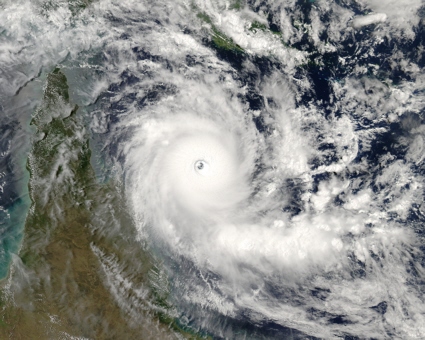
Cyclone Ingrid was just below Category-5 strength when the MODIS instrument on NASA's Aqua satellite captured this image on 2005 March 8. The storm had winds of 150 miles (240 kilometers) per hour and was bearing down on Australia's Cape York Peninsula. The image reveals Ingrid's large, clear eye as well as land and ocean details.
Aqua was launched aboard a Delta II rocket from Vandenberg AFB in 2002. NASA image courtesy of Jeff Schmaltz, MODIS Land Rapid Response Team, GSFC.
(MAR 12) Weather permitting, observers at suitable locations can catch a glimpse of the solar system's innermost planet for the next few evenings. Mercury attains its greatest angular separation from the Sun today at 10:00 PST (18:00 UTC) and should be visible very low in the west at dusk.
To see the elusive planet, look about 30 minutes after sunset from a location free of haze with an unobstructed western horizon. For observers in the Southwest, Mercury will be due west and 10° above the horizon. The planet shines at magnitude -0.2 and should resemble a semi-bright star.
(MAR 8) SANTA MARIA, CA -- Lockheed Martin's Range Standardization and Automation Phase IIA (RSA IIA) program office successfully completed early installation of components that will help improve launches at Vandenberg Air Force Base, CA.
Installed thirty days earlier than required, this highly automated, PC-based product suite facilitates flight operations on Vandenberg's Western Range permitting launch team members to improve launch flight safety operations management as well as perform post-flight analysis of launch and range operations.
Ralph Tourino, Vice President, Lockheed Martin Space Support and Ground Systems, said, "Lockheed Martin performance has been stellar on RSA IIA. Air Force Space Command is intent on improving the Western Range Operational Control Center (WROCC) through automation and modernization of equipment. One month ahead of schedule, we installed workstations, servers, consoles and infrastructure supporting Flight Operations and Analysis in the WROCC at Vandenberg Air Force Base."
Tourino said software delivery is scheduled for later this year.
Information courtesy of Lockheed Martin
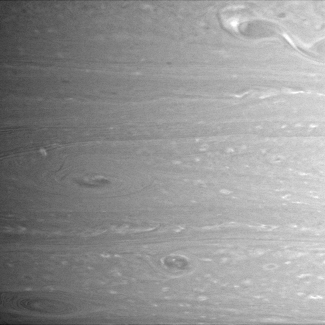
Exhibiting little detail when viewed through earth-based telescopes, Saturn's atmosphere features several storms in this infrared image from the Cassini spacecraft. The view was taken on February 5 by the craft's narrow angle camera from a distance of 2.1 million miles (3.4 million kilometers). Image courtesy of NASA/JPL/Space Science Institute
(MAR 3) BOULDER, Colo. - CloudSat, part of the multi-satellite, multi-sensor NASA experiment designed to measure the properties of clouds, has successfully concluded its final environmental test and was mated to the flight adapter interface in preparation for launch. More
(MAR 2) Weather permitting, observers across the Southwest have an opportunity to see the Moon occult Antares this Thursday morning. Antares is a fairly bright star, but binoculars or other optical assistance will be needed to see it disappear behind the Moon's sunlit limb.
However, the reappearance, which occurs on the dark limb, should be visible to the naked eye. Occultation expert David Dunham notes that Antares is a double star and that telescopic observers should see its +5.5 magnitude companion reappear just before the primary star.
The following table lists the disappearance and reappearance times for several southwestern cities:
| Location | Disappears | Reappears |
|---|---|---|
| Phoenix | 03:17 MST | 04:12 MST |
| Los Angeles | 02:19 PST | 02:57 PST |
| San Francisco | 02:15 PST | 02:55 PST |
| Denver | 03:18 MST | 04:31 MST |
| Albuquerque | 03:18 MST | 04:26 MST |
| Las Vegas | 02:14 PST | 03:08 PST |
| Reno | 02:12 PST | 03:04 PST |
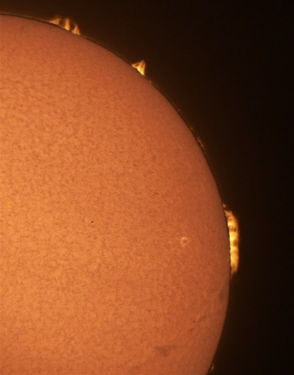
The otherwise featureless Sun sports a wealth of detail when viewed in the light emitted by hydrogen. This composite hydrogen light image captured on February 25 by Colorado astroimager Ginger Mayfield shows details on the solar disk and prominences on the limb. Image Copyright 2005, Ginger Mayfield
(FEB 27) Richard Schmude of the Association of Lunar and Planetary Observers reports that Jupiter's Great Red Spot (GRS) appears to have recently consumed two white ovals in the planet's atmosphere. He adds that another white oval on the southern edge of the South Equatorial Belt (SEB) may be swallowed up by the GRS in a month or so.
Suitably equipped amateurs are asked to image the GRS during the next two or three days and forward their results to Schmude. The images will be used to determine how fast the GRS is rotating.
To observe the above events visually, Schmude recommends using color filters and at least a well-collimated 8-inch Newtonian or a 6-inch refracting telescope.
The GRS will transit Jupiter's disk during the next few days at the following times (date and times UTC): February 28 06:26 and 16:22; March 1 02:17, 12:13, and 22:08; March 2 08:04 and 18:00; and March 3 03:55, 13:51, and 23:46.
(FEB 22) Dryden Flight Research Center is using an F-15B aircraft to study how insulation behaves as it is shed from the Space Shuttle's external fuel tank during launch. The data is being collected as part of the Shuttle Return to Flight effort. More
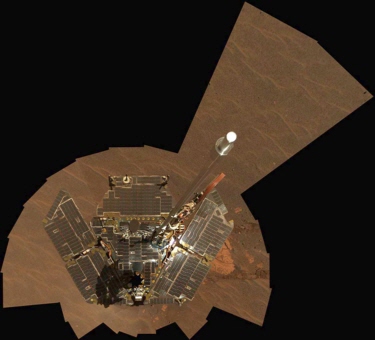
NASA's Mars Exploration Rover Opportunity used its panoramic camera to take the images combined into this mosaic view of the rover. The downward-looking view omits the mast on which the camera is mounted. It shows Opportunity's solar panels to be relatively dust-free. The images were taken through the camera's 600-, 530- and 480-nanometer filters during Opportunity's 322nd and 323rd martian days. Image courtesy of NASA/JPL/Cornell
(FEB 16) Another encounter of the Moon and a naked-eye planet occurs before dawn this weekend. During the night of February 19-20, the Moon and Saturn will gradually grow closer as a result of the Moon's eastward orbital motion. From downtown Los Angeles minimum separation occurs before dawn on February 20 at 03:59 PST (11:59 UTC) when the two objects will be 4.3° apart.
(FEB 15) NASA's Spirit rover found a new class of water-affected rock, while its twin, Opportunity, finished inspecting its own heat shield and set a new martian driving record. The rovers successfully completed their three-month primary missions in April 2004 and are working on extended exploration missions. More

This February 6 view from the MODIS instrument on NASA's Aqua satellite shows bright snow creating a black and white landscape over the northeast U.S. A red dot at the bottom of the image marks where MODIS detected a fire near Chesapeake Bay. Image courtesy of MODIS Land Rapid Response Project, NASA GSFC.
(FEB 11) Lockheed Martin's first Atlas V booster for launch from the West Coast has arrived at Vandenberg Air Force Base. The booster and Centaur upper stage made separate trips from Denver aboard an An-124-100 aircraft. In March the Atlas team will transport the rocket segments to pad SLC-3E in preparation for a launch later this year. More
(FEB 9) Strong westerly winds of up to about 400 kilometers per hour (250 miles per hour) buffeted the Huygens probe as it descended through Titan's upper atmosphere last month, according to NASA-led observations of the probe transmissions with Earth-based radio telescopes. More
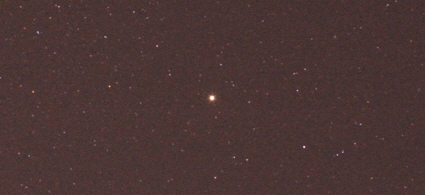
![]()

Known for its red hue, Betelgeuse (top) is one of the winter sky's brightest stars. The webmaster placed a diffraction grating in front of his digital camera last Thursday to spread the star's light into a spectrum (bottom). The spectrum's dark bands were caused by the absorption of specific colors by molecules in Betelgeuse's atmosphere. Copyright 2005, Brian Webb.
(FEB 4) Edwards AFB, California - A large hybrid rocket motor was successfully fired here recently.
The test occurred on a Air Force Research Laboratory test stand overlooking Edwards' dry lake bed and surrounding desert as part of the Air Force small launch vehicle office's Falcon program.
The program is a 36-month long effort to develop and demonstrate an affordable and responsive launcher capable of placing a small, 1,000-pound satellite into a circular, 100 nautical mile orbit.
The hybrid rocket differs from liquid fueled and solid propellant fueled rockets, because it combines technologies from both types of launchers. Typically, a hybrid rocket uses a rubberized fuel and liquid oxygen to generate thrust, officials said.
The research site encompasses 65 square miles of Edwards AFB. Its unique research and development facilities provide state-of-the-art capabilities for researchers who provide the nation with the latest rocket propulsion technology possible.
Information courtesy of U.S. Air Force
(JAN 31) NOAA satellites, including polar-orbiting spacecraft launched from Vandenberg AFB, played a key role in rescuing 260 people throughout the United States and surrounding waters in 2004. The NOAA satellites along with Russian spacecraft, are part of an international system that uses satellites to detect and locate distress signals from emergency beacons. More
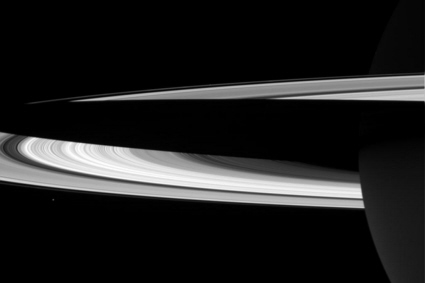
This visible light Cassini image shows Saturn's shadow stretching across the sunlit southern surface of its rings. The photo was taken with the spacecraft's wide-angle camera on January 17 at a distance of approximately 746,000 miles (1.2 million kilometers) from Saturn. The planet's night side is visible at the right. Image courtesy of NASA/JPL/Space Science Institute
(JAN 29) Observers across the Southwest have an opportunity to see a near miss early Monday as the Moon's orbit carries it close to Jupiter. As seen from Los Angeles, closest approach occurs at 00:07 PST (08:07 UTC) on January 31 when the objects will be separated by 0.75°. The Moon will pass in front of the planet for observers in the south-central Pacific and part of Antarctica.
(JAN 27) An international team of scientists embarked this week on a journey to conduct high quality measurements of the Arctic region's atmosphere. The Polar Aura Validation Experiment (PAVE) will gather information to validate data from NASA's Aura satellite, which was launched from California last summer. More
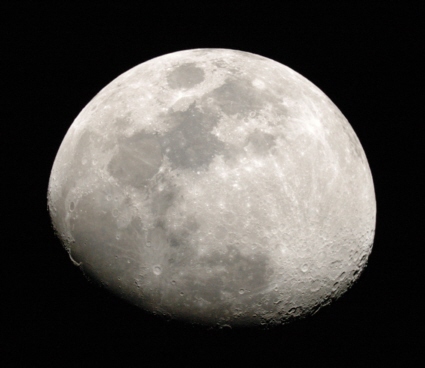
The Moon dominated the evening sky this week and provided the webmaster with a convenient photographic target. This experimental image of Earth's nearest neighbor was taken Thursday evening with an 8-inch Schmidt-Cassegrain telescope and Nikon D70 digital camera. Copyright 2005, Brian Webb.
(JAN 19) NASA's Mars Exploration Rover Opportunity has found the first meteorite ever identified on another planet. The pitted, basketball-size object is mostly made of iron and nickel. Dubbed "Heat Shield Rock," the meteorite sits on Meridiani Planum, a cratered flatland that Opportunity has been exploring for nearly a year. More
(JAN 19) Scientists at Georgia State University have used a telescope array atop California's Mount Wilson to obtain an unprecedented close-up of the bright star Regulus. A computer-generated model of the star based on data from the array shows that Regulus' frenetic spin has distorted it into the shape of a squashed beach ball. More
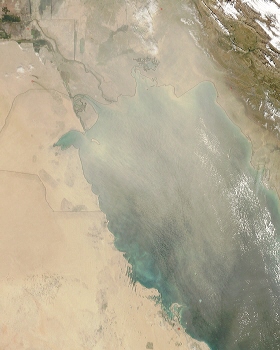
Tan clouds of airborne dust blowing from Iraq and Iran obscure the Persian Gulf in this January 7 image from the MODIS instrument onboard NASA's Terra spacecraft. MODIS also detected a few scattered fires (marked with very small red circles) and smoke plumes in the region. Terra rocketed into orbit from Vandenberg AFB in 1999. Image courtesy of Jeff Schmaltz, MODIS Land Rapid Response Team, NASA GSFC.
(JAN 14) Sunspot 10720 began as a speck that was barely visible with a telescope. But the spot has grown so dramatically in the past few days it is now reportedly visible to the naked eye when viewed through eye-safe solar filters.
720's growth has also made it a potential source of powerful M and X-class solar flares which can cause radio blackouts ranging from brief outages in the Earth's polar regions to global interruptions. Solar Terrestrial Dispatch also reports the spot will be well positioned to hurl coronal mass ejections towards Earth during the coming week.
For information on how to safely observe sunspot 10720, click here.
(JAN 12) Weather permitting, observers in Southwest will be treated to a close planetary conjunction this Thursday (January 13). Mercury and Venus will be less than half a degree apart when they rise 75-minutes before the Sun.
To view this close planetary pairing, find a location with an unobstructed horizon and look low in the east about 40-minutes before sunrise. Venus will look like a bright white "star". The much fainter Mercury will be immediately to Venus' right.
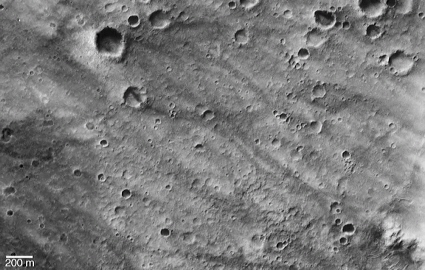
Wheel tracks (dark lines) left by the NASA rover Spirit's 2-mile (3-km) trek from its landing site to the Columbia Hills are visible in this composite image from NASA's Mars Global Surveyor. The largest crater, Bonneville Crater, is about 230 yards (210 m) in diameter. Image courtesy of NASA/JPL/MSSS
(JAN 7) Images returned by NASA's Cassini spacecraft cameras during a New Year's Eve flyby of Saturn's moon Iapetus (eye-APP-eh-tuss) show startling surface features that are fueling heated scientific discussions about their origin. More
(JAN 6) After more than four years of processing data, NASA and the National Geospatial-Intelligence Agency have completed Earth's most extensive global topographic map. The data, extensive enough to fill the U.S. Library of Congress, was gathered during the Space Shuttle Endeavour Radar Topography Mission in 2000. More
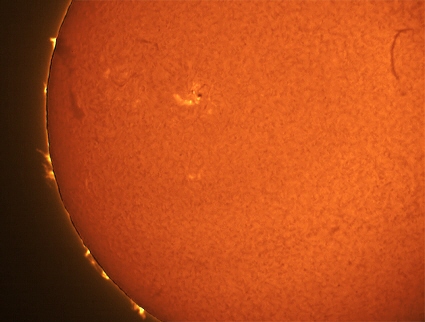
A hydrogen light image of the Sun taken on January 1 by Ginger Mayfield of Divide, Colorado. This view shows prominences on the Sun's edge and detail on the disc including sunspot 715 (next to the bright arc-shaped area) which unleashed a powerful X-class solar flare on New Year's Eve. Image copyright 2005, Ginger Mayfield. Used with permission.
(JAN 2) A comet discovered last summer reaches its greatest brightness this month and is now conveniently placed for observation. Officially designated C/2004 Q2, Comet Machholz was discovered by comet hunter Don Machholz of Colfax, California on August 27 as he was swept the pre-dawn sky with his telescope.
The object has since brightened substantially and moved into the evening sky where it is currently visible from dark sites with the naked eye and the suburbs with binoculars. Comet Machholz is expected to brighten further in early January and may reach naked eye visibility for some city dwellers.
To see Machholz's comet, look high in the east about 90 minutes after sunset and locate the Pleiades, a small patch of several semi-faint stars. On the evening of January 2, the comet will be about 11° to the stars' lower right. Over the next several evenings C/2004 Q2 will gradually climb and move towards the left, passing just to the right of the Pleiades on January 7.
If the sky is too bright at your location to find the comet with the naked eye, try searching with binoculars. Comet Machholz will resemble a large, fuzzy patch. Binoculars or a telescope may reveal the comet's blue-green color and tail.
Copyright © 2005-2016, Brian Webb. All rights reserved.